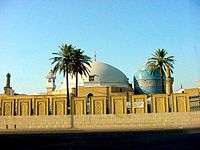Amrohi Syed
| Regions with significant populations | |
|---|---|
| Languages | |
| Religion | |
|
| |
| Related ethnic groups | |
The Sadaat Amroha or Amrohi Syed are a community of Sayyids, historically settled in the town of Amroha, in the Indian state of Uttar Pradesh.[1] Many members of the Sadaat Amroha community migrated to Pakistan after independence and settled in Karachi, Sindh.
History
The town of Amroha is home to one of the oldest Naqvi Sadat settlements in India. Naqvis in Amroha arrived from Wasit, Iraq and have resided in the town of Amroha since A.D. 1190 [2]
The Sadaat Amroha belong mainly to the Naqvi sub-group, because they are descendants of the Sufi saint Hazrat Syed Sharfuddin Shah Wilayat (a true 9th direct descendant of Imam Ali Al-Naqi), who was a highly respected religious figure in Wasit, Iraq, and later in India during the early ages of Islam in the South Asia and the khalifa of Hazrat Imam Suhrawardi R. The majority of Amrohvie Sadaat are Naqvi, predominately of Shia sects. According to the 1901 Census of India, the main sub-division of the Sayyid was the Husseini and Naqvi.
Syed Hussain Sharfuddin Shah Wilayat Naqvi
Syed Hussain Sharfuddin Shah WilayatNaqvi (Arabic: سید حسین شرف الدين شاه ولايت ) was a prominent 13th-century Sufi or Makhdoom.[3] He is the ninth descendant of Ali al-Naqi.
Syed Husain Sharfuddin Naqvi "Shah Wilayat" was a son of Syed Ali Buzurg Wasiti.
His ancestor migrated from Al-Wasit "Iraq" to Bukhara "Uzbekistan", his family re-migrated to Sahudra (Punjab) near Uch Sherif. He was born in 1255 AD in Sahudra.(ancient city of Punjab)
He married to his maternal cousin named Fatimatut Tahira, she was a daughter of Jalaluddin Surkh-Posh Bukhari.
Makhdoom Jahaniyan Jahangasht was nephew of Dadi Fatimatut Tahira. His father, Syed Ahmed Kabir, was the youngest son of Syed Jalaluddin Bukhari.
Dada Shah Wilayat was a Sufi Saint of Sisila-e-Suhrawardiyya & achieved the highly honored designation of "Shah Wilayat".
He was appointed to Amroha, India by his Sisila for preaching Shariat, Tariqat & Haqiqat.
"Adal" means "equability" in Urdu. He was awarded this title because of his great courage and justice in dealing with war prisoners in the Second Battle of Panipat. Syed Muhammad Mir was also governor of Sindh and Mir Saiyyed Dost Ali Naqvi who fought with exemplary bravery in the Third Battle of Panipat along with the Nawab of Najibabad (against the Marathas) and almost died in action.
He was the first Urdu poet of north India and was the mentor of Mer Taqi Meer. The most distinguished Urdu poet were the descendants of Syed Hussain Sharfuddin Shah Wilayat Naqvi.
Local legend says that the animals who live in his mazar (shrine), especially scorpions, never harm humans.
Present circumstances
The Sadaat Amroha are divided among those that remained in India and those that emigrated to Pakistan. The Anjuman Sadaat Amroha is the community's main organization.[4]
They joined the South Asian diapora, with communities in North America. The Sadaat Amroha speak Urdu and rarely use dialects such as Khari boli.
References
- ↑ People of India Uttar Pradesh Volume XLII Part Three by K S Singh page 1248
- ↑ A Socio-Intellectual History of the Ithna ashari Shia in India by S A Rizvi
- ↑ "Amroha". aulia-e-hind.com. Retrieved 22 September 2016.
- ↑ "Anjuman-E-Sadat-E-Amroha-Delhi". Archived from the original on 16 January 2005.
